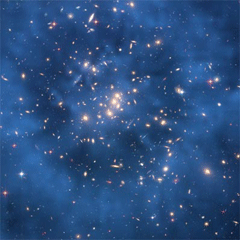Cosmic Quandaries
Air Date: Week of June 8, 2007

A composite image from the Hubble Space Telescope shows a phantom "ring" of dark matter in the galaxy cluster ZwC10024+1652. (Courtesy of NASA, ESA, M.J. Jee and H. Ford et al. (John Hopkins U.))
Space is full of bizarre objects and mysterious forces, but perhaps none is more puzzling than something called "dark matter." Living on Earth host Bruce Gellerman talks with Neil deGrasse Tyson, director of New York’s Hayden Planetarium, about the nature of dark matter and about a new planet recently discovered outside our solar system that might host life.
Transcript
GELLERMAN: It’s Living on Earth. I’m Bruce Gellerman. Just ahead: music to the ears for geologists. But first: When it comes to the universe seems, we ain’t seen nothing yet. That’s because astrophysicists estimate 95 percent of the cosmos can’t be seen. It’s invisible. They call the mysterious stuff “dark matter.” But now, astronomers using the Hubble telescope have detected a shadowy ring inside a cluster of galaxies they believe might be the first glimpse of dark matter. Like pebbles in a pond, the ghostly ring is evidence that something big and powerful is affecting the galaxies…only we can’t see it directly.
Well, when things astronomical leave us in the dark, we call upon Neil deGrasse Tyson.
Dr. Tyson is director of the Hayden Planetarium in New York City and author of the new book “Death by Black Hole and Other Cosmic Quandaries.” So, Dr. Tyson can you shed some light just what is dark matter?
TYSON: We have no idea. Well, that’s not true. We have some ideas but none of them have any experimental foundation yet. Dark matter is a little bit misnamed. We should probably think of it as dark gravity because there is a source of gravity out there whose point of origin remains a mystery. So it’s really dark gravity.
GELLERMAN: So, how do we know that it’s out there?
TYSON: Because we see massive systems of galaxies where if you add up all of the matter in the galaxies, even stars, gas clouds and even black holes, add it all up and account for the gravity it should have. It is a fraction of the total gravity exhibited in the entire cluster.
GELLERMAN: So, how is dark matter then different from regular matter?

Neil deGrasse Tyson is director of New York’s Hayden Planetarium (Courtesy of Patrick Queen© Reprinted by permission of Prometheus Books)
GELLERMAN: I’ve heard that WIMPS might be dark matter.
TYSON: Yeah, that’d be weakly interactive massive particles. Massive in this case would be sort of high mass when compared with a particle, not compared with a galaxy. And so that’s just an acronym to contain our ignorance of what it might be suggesting that it’s some kind of particle that doesn’t interact with our particles and in that way would be completely invisible to us.
GELLERMAN: So, the weak may inherit the earth but it’s the wimps who get the universe.
MUSIC: The Tornadoes “Life On Venus” from “Vampires, Cowboys, Spacemen And Spooks: The Very Best Of Joe Meek’s Instrumentals’ (Rykodisk – 2007)
TYSON: (laughs)
GELLERMAN: You think wimps are weird how about life on other planets? Well, 12 years ago scientists discovered the first planet outside our solar system revolving around another star and since then they’ve catalogued over 300 more. The latest of these so-called exo-planets was recently discovered and Dr. Tyson says this one looks a lot like planet Earth.
TYSON: Here’s the challenge: the planet itself at those distances is so small, so dim, we don’t see them directly. They’re discovered by observing the effect of their gravity on the host star, which does show up in your telescopes. We see their effect on the host star. And so the catalogue is filled with planets that are like the size of Jupiter and bigger. And we’re not thinking that life as we know it would thrive on a Jupiter, maybe on a Jupiter moon but not on a Jupiter. And so the holly grail out there has been, ‘can we find a planet that resembles earth?’ And just recently one such planet was discovered.
GELLERMAN: What’s it called?
TYSON: There’s a catalogue of nearby stars that are kind of sun-like and it’s called the Gliese Catalogue G-L-I-E-S-E Gliese Catalogue and this is one of the stars in that catalogue. And this is one of the stars in that catalogue. Ands so it’s named for that catalogue, so it’s Gliese 581-C is the name of the planet.
GELLERMAN: So, what are the odds that it has life on it?
TYSON: Oh, what I left out is, ok it’s great that you find planets but what really matters is you want to know how far from the host’s star is it? If it’s too close if there were any water on the planet it would evaporate. If it’s too far from the host planet, it would freeze. And life as we know it requires liquid water. So there’s this Goldilocks zone in the vicinity of every star out there. The sun has a Goldilocks zone they all do. This earth-like planet was discovered orbiting the Goldilocks zone of that host star. So, if it’s going to have life as we know it it’s a pretty good chance of it given its location.

A composite image from the Hubble Space Telescope shows a phantom "ring" of dark matter in the galaxy cluster ZwC10024+1652. (Courtesy of NASA, ESA, M.J. Jee and H. Ford et al. (John Hopkins U.))
TYSON: Well, you know I can give it to you in miles and it will sound impossibly far, which it is, except it’s one of the closest stars to us in whole the galaxy. So, it’s a reminder of how vast space is and the galaxy is and the rest of the cosmos is. It’s about 20 light years away.
GELLERMAN: Oh, well, that’s right around the corner.
TYSON: I know but if you put that in miles it’s like 120 trillion miles. So it would take you (muttering calculations) it would take you 300,000 years to get there going on the fastest spaceships ever built.
GELLERMAN: How would they detect if there were life on this planet? How would we know?
TYSON: Excellent question. Well, if there’s intelligent life with technology you can imagine just beaming radio signals there because radio will get there in 20 years at the speed of light, radio waves is a form of light. And if it’s 20 light years away, it takes 20 years for the signal to get there. So you send it some signal saying, “Hi, how are you doing? We’re over here. Here’s some stuff we learned about our place in the universe.” And then they would receive it and maybe send a reply. And so this would not be a sort of witty repartee because a roundtrip conversation takes 40 years. But that could work. But another way to discover life is an emerging field called the search for biomarkers. On earth we have oxygen in our atmosphere and oxygen is a sign that there’s life on earth. If you took away life the oxygen would all go away. So would the methane. There are certain molecules that are only kept there by the action of life. So, as you look to other planets you’re going to look for oxygen. You’re going to look for methane. So these are biomarkers. Another fascinating biomarker might be smog. I don’t know if that’d be a sign of intelligence or not, but it certainly would be a sign of life.
GELLERMAN: Well, Dr. Tyson, it’s been a real pleasure. I enjoyed it a lot.
TYSON: Thanks, thanks for having me.
GELLERMAN: Astrophysicist Neil Tyson regularly explores the cosmos for Living on Earth and hosts the PBS TV series: “Nova Science Now.” So, let’s say there is life on Gleise 581 C and let’s say they’re tuning in to Earth right now from 20 light years away. They’d just be receiving broadcasts from 1987: that’s the year wrestle mania set a record for indoor attendance at a sporting event, Prozac made its debut in drug stores, the world’s first conference on artificial life was held, and Michael Jackson was doing the moon walk. It was an interesting year.
MUSIC: GLIESE 581 C MONTAGE: Clips in order of Appearance…
1.) Michael Jackson “BAD” from ‘1987 World Tour’ (Tokyo, Japan - 1987)
2.) Oliver North “Iran-Contra Scandal” Shredding Quote (1987)
3.) Gunnery Sergeant Hartman “Full Metal Jacket” by Stanley Kubrick Film Clip (Warner Bros. Pictures - 1987)
4.) Public Enemy “You’re Gonna Get Yours” from ‘Yo! Bum Rush The Show’ (Def Jam Records – 1987)
5.) Ronald Reagan “Tear Down This Wall” Speech (Berlin Wall, West Germany - 1987)
6.) Los Angeles Lakers NBA Champions (Los Angeles Lakers Stadium - 1987)
7.) SEGA Master System Video Game TV Commercial (Sega Corp. - 1987)
8.) The David Letterman Show “Stupid Pet Tricks” (NBC TV – 1987)
9.) Michigan TV Newscast “Ford Motor Company Profits” (WJBK2 TV - 1987)
10.) Yogurt “Spaceballs” by Mel Brooks Film Clip (MGM/UA - 1987)
GELLERMAN: 1987, as heard on exo-planet Gleise 581 C today.
Links
Living on Earth wants to hear from you!
Living on Earth
62 Calef Highway, Suite 212
Lee, NH 03861
Telephone: 617-287-4121
E-mail: comments@loe.org
Newsletter [Click here]
Donate to Living on Earth!
Living on Earth is an independent media program and relies entirely on contributions from listeners and institutions supporting public service. Please donate now to preserve an independent environmental voice.
NewsletterLiving on Earth offers a weekly delivery of the show's rundown to your mailbox. Sign up for our newsletter today!
 Sailors For The Sea: Be the change you want to sea.
Sailors For The Sea: Be the change you want to sea.
 The Grantham Foundation for the Protection of the Environment: Committed to protecting and improving the health of the global environment.
The Grantham Foundation for the Protection of the Environment: Committed to protecting and improving the health of the global environment.
 Contribute to Living on Earth and receive, as our gift to you, an archival print of one of Mark Seth Lender's extraordinary wildlife photographs. Follow the link to see Mark's current collection of photographs.
Contribute to Living on Earth and receive, as our gift to you, an archival print of one of Mark Seth Lender's extraordinary wildlife photographs. Follow the link to see Mark's current collection of photographs.
 Buy a signed copy of Mark Seth Lender's book Smeagull the Seagull & support Living on Earth
Buy a signed copy of Mark Seth Lender's book Smeagull the Seagull & support Living on Earth

